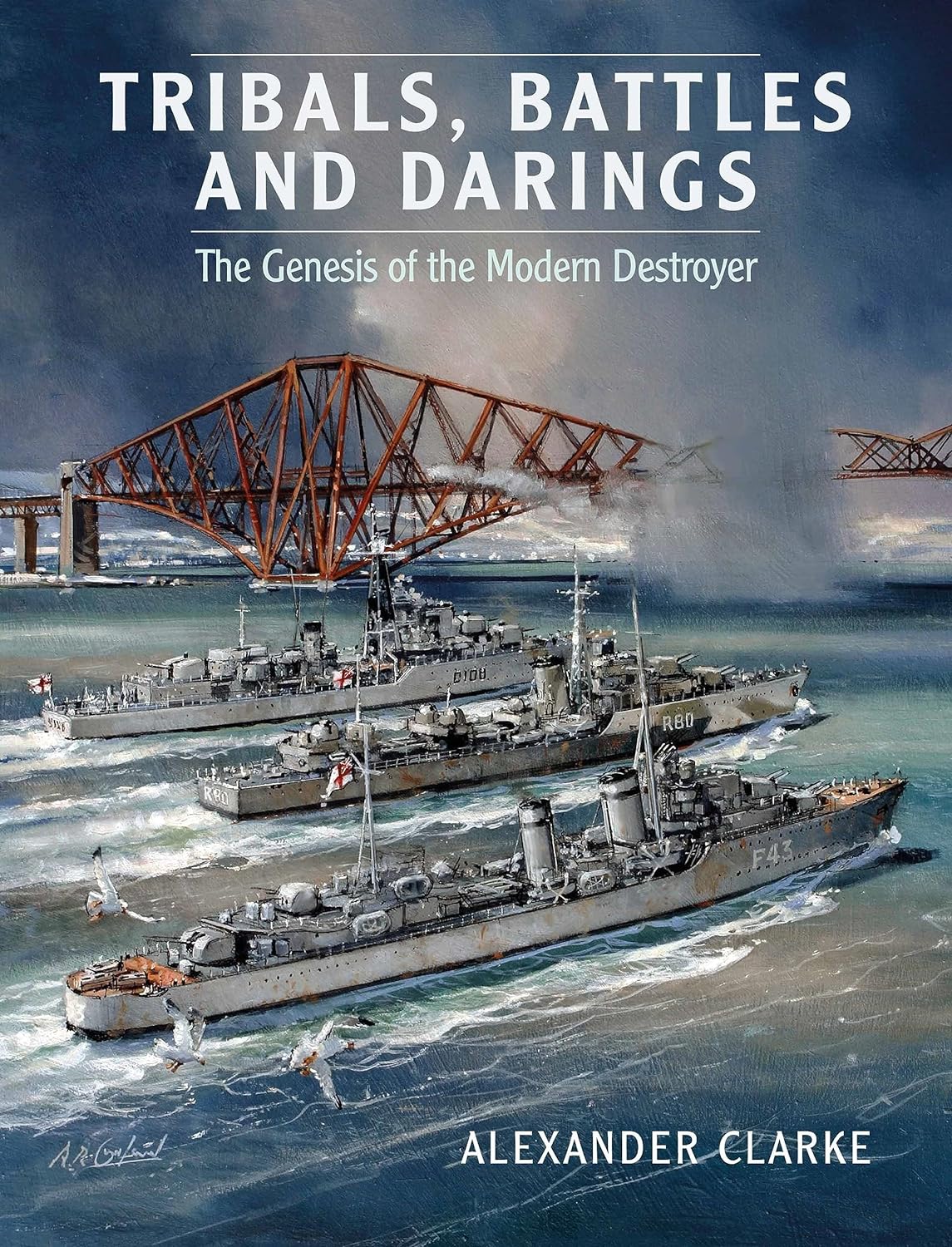Tribals, Battles, and Darings: The Genesis of the Modern Destroyer
By Alexander Clarke

In Tribals, Battles and Darings, Alexander Clarke follows the transition of the destroyer from a small ship suited to a single mission during the First and Second World Wars, into the modern incarnation of a larger ship, suited to multiple missions. He examines the Royal Navy's push to acquire larger, more versatile destroyers in the years leading up to the Second World War, and the continued need for them during the conflict. Not only does he focus on the political and financial considerations that affected naval procurement during the final years of the interwar period, he also describes how larger destroyers helped fill in the gaps within the Royal Navy during the interwar period due to political and financial considerations. He then looks at the personalities who commanded and fought these ships and their role in both peace and wartime. What emerges is not a history of any of the three classes discussed, rather it is an illustration of how destroyers evolved from smaller ships suited to single missions, and operating as part of a larger force, to warships that could perform multiple duties proficiently, and operate independently without the need for a larger fleet to provide support. The transition from specialist vessels to jacks of multiple, if not all, trades is clearly explained.
Starting with the Tribal class destroyer, Clarke explores why the Royal Navy needed such large, powerful escort ships with heavy guns and how they were used as fast destroyers suited to the conduct of war, as well as maintaining peace. He then explores the circumstances and technological advances, such as radar, that required something suited to a different set of criteria; namely, losses due to aerial bombardment. This was the Battle-class of destroyers. Finally, he transitions into the post-war period and the D or Daring class of destroyers built for the Royal Navy and the Royal Australian Navy, the largest and most heavily armed of the three classes.
Through a series of anecdotes he explores the missions performed by various ships in the classes discussed, and the colorful personnel who advocated for, and commanded these ships. The result is a highly readable account of the role Royal Navy destroyers played during and after the war that is accessible to both students of naval history and those new to the subject. This book is not a history of any one of the classes, although Clarke does provide sources for those who want to learn more about the topic. What this is, is an exploration of how one type of warship transitioned from plan to construction to implementation to something similar yet different.
Impeccably researched, this book provides a wealth of both primary and secondary references for readers at all levels, especially those who want to conduct further research. Written in a very informal style, it is accessible to both  the layman and the serious academic. While light on the technical specifications for the ships discussed, Clarke's work is packed with blueprints and pictures that describe how the ships were constructed, and the role that appearances play in both the design and perception of warships, both in times of war and peace. He does point out in several places the construction considerations that were taken into account for all of these ships, considerations that allowed them to conduct missions and survive damage that would have sunk lesser ships fulfilling similar roles. Without being overcome by minutia, Clarke explores a group of ships from conception to introduction, through application while offering enough depth to provide something useful to students looking for something new.
the layman and the serious academic. While light on the technical specifications for the ships discussed, Clarke's work is packed with blueprints and pictures that describe how the ships were constructed, and the role that appearances play in both the design and perception of warships, both in times of war and peace. He does point out in several places the construction considerations that were taken into account for all of these ships, considerations that allowed them to conduct missions and survive damage that would have sunk lesser ships fulfilling similar roles. Without being overcome by minutia, Clarke explores a group of ships from conception to introduction, through application while offering enough depth to provide something useful to students looking for something new.
As good as it is, the book is not without shortcomings, the most obvious one being what Clarke does not discuss. While determining why these ships were constructed and what they did during the Second World War, there is less attention paid to the post-war period, particularly the Battle and Daring classes, which had long post-war careers, well into the Cold War. They were present in various conflicts, with various navies, well into the later half of the twentieth century. The lack of exploration of this territory, whether limited by considerations of length, or because it would detract from the author's central thesis, leaves plenty of room for further research.
Tribals, Battles and Darings opens a window into a period of transition for warships while offering an accessible starting place for looking at the people, events, and ships that influenced this unique period in history. It also provides a clear and straightforward examination of the final stages of the transition of the destroyer from ships suited to a single mission to ships that needed to perform a variety of functions in a changing world.
- Barnsley: Seaforth Publishing, 2022
- Annapolis: Naval Institute Press, 2022
- 8” x 10-1/2”, hardcover, 176 pages
- Photographs, drawings, tables, notes, bibliography, index. $52.95
- ISBN: 9781526772909
Reviewed by: Kenneth Markle, New Orleans, Louisiana
